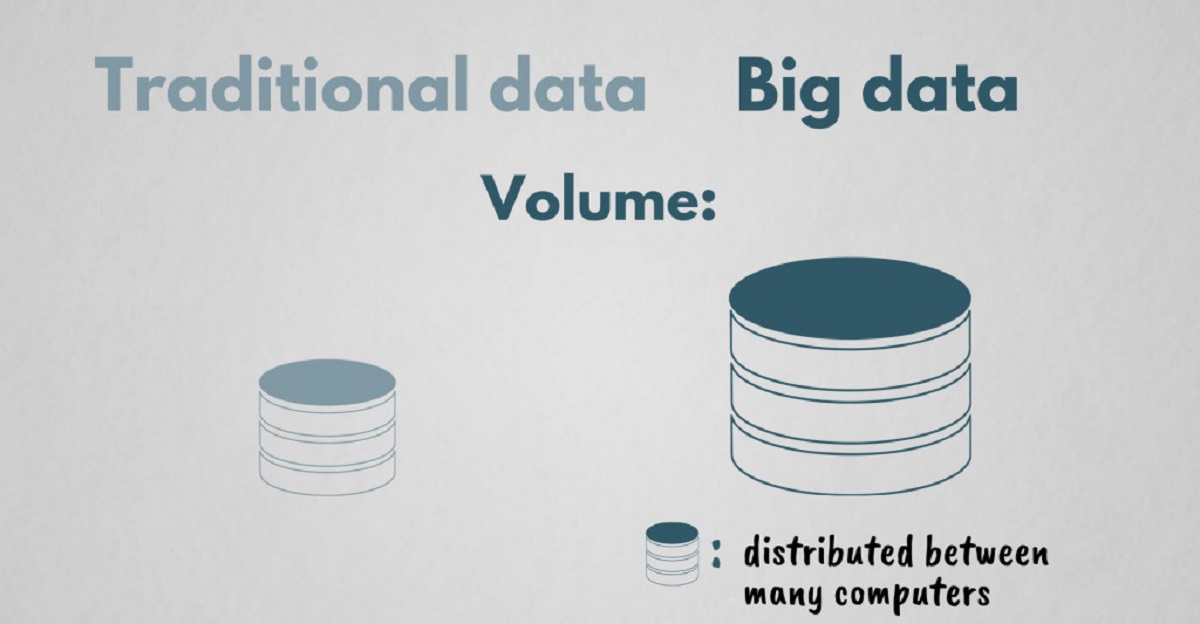Introduction
With the exponential growth of data in the digital age, storing and managing large volumes of information has become a significant challenge for organizations. This has given rise to the concept of “Big Data”, which refers to the massive amounts of data that businesses and institutions generate and collect on a daily basis. The ability to effectively store and access this data is critical for extracting actionable insights and making informed decisions.
Traditional data storage methods, such as relational databases, are not designed to handle the vast scale and complexity of Big Data. These systems often struggle with issues of scalability, performance, and cost-effectiveness. As a result, new storage approaches and technologies have emerged to address the unique requirements of Big Data processing and analysis.
This article will explore various methods and technologies used for storing Big Data, including distributed file systems and NoSQL databases. We will discuss the challenges associated with storing and managing Big Data and how these new approaches provide solutions to overcome these hurdles. By the end, you will have a better understanding of the different options available for storing and analyzing Big Data and how they can be leveraged to gain valuable insights.
Understanding Big Data
Before diving into the various storage methods for Big Data, it is essential to have a good grasp of what Big Data actually entails. Big Data refers to the vast and complex sets of data that cannot be effectively handled using traditional data processing methods. It is characterized by the three V’s: volume, velocity, and variety.
The first aspect of Big Data is volume. Traditional data storage solutions are designed to handle relatively small amounts of data. However, with the explosion of digital transactions, social media interactions, and sensor-generated data, the volume of data being generated is soaring. Big Data storage methods need to be able to accommodate and process these immense volumes of data efficiently.
The second aspect is velocity, which relates to the speed at which data is generated and needs to be processed. With the rapid growth of connected devices, real-time data streaming, and social media feeds, the speed at which data is being generated and updated is staggering. To extract valuable insights from Big Data, storage methods must be capable of handling high-velocity data streams and processing them in near real-time.
The final aspect is variety, referring to the diverse types and formats of data that make up Big Data. Traditional structured data, such as tables and spreadsheets, is only a fraction of the data being generated today. Unstructured data, such as social media posts, images, videos, and sensor data, present new challenges for storage and analysis. Big Data storage methods must be flexible enough to handle this variety of data types and enable seamless integration and analysis.
Understanding the unique characteristics of Big Data is crucial because it impacts the choice of storage method. Traditional relational databases are ill-suited to handle Big Data due to their limitations in scalability, performance, and flexibility. New storage methods and technologies have emerged to address these challenges and provide scalable, high-performance solutions.
In the following sections, we will explore these advanced storage methods, including distributed file systems and NoSQL databases, that have been specifically designed to handle the demands of Big Data. By leveraging these storage technologies, organizations can unlock the potential of their Big Data and gain valuable insights that drive innovation and competitive advantage.
Traditional Data Storage Methods
Before the emergence of Big Data, organizations primarily relied on traditional data storage methods, such as relational databases, to manage their data. These databases are structured, with predefined schemas that enforce data integrity and provide efficient queries. While these methods have served organizations well for many years, they face significant challenges when it comes to handling the volume, velocity, and variety of data associated with Big Data.
Relational databases are based on the relational model, where data is organized into tables with rows and columns. They are designed for structured data with well-defined relationships between entities. However, when it comes to handling Big Data, relational databases encounter limitations:
- Scalability: Relational databases may struggle to scale horizontally to accommodate the growing volume of data. Adding more servers to handle the data load can be complex and costly.
- Performance: As the data size increases, traditional databases may experience slower query performance, impacting the speed at which insights can be extracted from Big Data.
- Flexibility: Storing and analyzing unstructured data, such as text documents or multimedia files, is a challenge in relational databases, which are designed for structured data.
In addition to relational databases, other traditional data storage methods include file systems and data warehouses. File systems, like those found in operating systems, provide a hierarchical structure for organizing and storing files. However, they lack the ability to efficiently process and analyze large amounts of data.
Data warehouses, on the other hand, are designed to store and manage large amounts of structured data from various sources. They employ techniques such as data normalization and indexing to optimize query performance. However, data warehouses are not well-suited for handling the volume, velocity, and variety of Big Data.
While traditional data storage methods have their benefits, their limitations in handling Big Data have led to the development of new storage approaches and technologies. In the next sections, we will explore these innovative methods, which are specifically designed to address the challenges of storing and analyzing Big Data.
Challenges of Storing Big Data
Storing Big Data poses unique challenges that traditional data storage methods are not equipped to handle. These challenges arise from the sheer volume, velocity, and variety of data generated in today’s data-driven world. Understanding these challenges is crucial for organizations to effectively store and manage their Big Data.
Scalability: One of the primary challenges of storing Big Data is scalability. The volume of data that organizations produce and collect is growing at an unprecedented rate. Traditional data storage solutions may struggle to handle this massive scale. As the amount of data increases, storage systems must be capable of seamlessly scaling horizontally by distributing the data across multiple servers or nodes.
Performance: Another challenge is ensuring optimal performance when processing and analyzing Big Data. With the high velocity at which data is generated, storage systems need to handle real-time data processing and analytics effectively. Slow query performance can hinder the ability to extract insights in a timely manner and make informed decisions.
Data Variety: The variety of data formats and types further complicates the storage of Big Data. With unstructured and semi-structured data sources such as social media posts, images, videos, and sensor data, traditional storage methods that primarily handle structured data struggle to accommodate this data variety. Storage systems must be flexible enough to handle diverse data types and provide mechanisms for integrating, organizing, and querying them effectively.
Data Integration: Integrating data from multiple sources is crucial for gaining a holistic view and deriving insights from Big Data. However, traditional storage methods often lack the ability to seamlessly integrate data from disparate sources. Storage systems must provide mechanisms for integrating data from internal and external sources to enable comprehensive analysis.
Data Security and Privacy: As the volume and variety of data grow, ensuring data security and privacy becomes increasingly challenging. Big Data storage methods must incorporate robust security measures to protect sensitive information from unauthorized access, while also complying with data protection regulations.
Data Governance: Lastly, managing and governing Big Data can be complex. With multiple data sources, data quality issues, and data ownership challenges, organizations need proper data governance frameworks and processes to ensure data integrity, consistency, and compliance.
Addressing these challenges requires innovative storage methods and technologies that can effectively handle the scale, speed, and diversity of Big Data. In the following sections, we will explore some of these solutions, including distributed file systems and NoSQL databases, which have emerged as popular choices for storing and managing Big Data.
Distributed File Systems
Distributed file systems have emerged as a popular storage solution for Big Data due to their ability to handle large volumes of data across multiple servers or nodes in a distributed manner. These systems provide a scalable and fault-tolerant infrastructure for storing and accessing data in parallel, making them well-suited for the challenges of storing and processing Big Data.
A distributed file system divides the data into smaller chunks and distributes them across multiple servers in a cluster. Each server stores a portion of the data, and the file system provides a unified interface for accessing and managing the distributed data. This distributed architecture enables horizontal scalability, as more servers can be added to the cluster to accommodate increasing data volumes.
One of the most well-known distributed file systems is the Hadoop Distributed File System (HDFS). HDFS is designed to handle the massive scale of Big Data and provides several key features:
- Distributed Storage: HDFS stores data across multiple servers, ensuring fault tolerance and high availability by replicating the data across different nodes in the cluster. This redundancy provides data durability, even in the event of node failures.
- Parallel Processing: HDFS enables parallel data processing by distributing the computation tasks across the cluster. This parallelization allows for efficient data analysis and processing of Big Data in a distributed environment.
- Scalability: With HDFS, organizations can easily scale their storage infrastructure by adding more servers to the cluster. This horizontal scalability ensures that growing data volumes can be accommodated without sacrificing performance or reliability.
- Data Locality: HDFS optimizes data processing performance by moving computation tasks closer to where the data is stored. This reduces network bandwidth requirements and improves overall data processing efficiency.
By leveraging distributed file systems like HDFS, organizations can overcome the challenges of storing Big Data. These systems provide a scalable and fault-tolerant infrastructure, enabling efficient storage, processing, and analysis of massive datasets. However, distributed file systems have certain limitations, especially when it comes to handling real-time data processing and complex data querying. To address these limitations, organizations turn to alternative storage solutions such as NoSQL databases, which we will explore in the next section.
Hadoop Distributed File System (HDFS)
The Hadoop Distributed File System (HDFS) is a distributed file system designed to store and manage Big Data across a cluster of computers. It is one of the key components of the Apache Hadoop framework, which is widely used for Big Data processing and analysis.
HDFS is built to handle the challenges associated with storing and processing massive amounts of data. It achieves this through a distributed and fault-tolerant architecture that provides scalability, high availability, and data reliability.
One of the key features of HDFS is its ability to store data in a distributed manner. Large files in HDFS are split into smaller blocks, typically 128 MB or 256 MB in size, and distributed across multiple servers in the cluster. This approach enables parallel processing of data, as different blocks of the same file can be processed simultaneously on different nodes.
HDFS ensures data reliability and fault tolerance through data replication. Each block in HDFS is replicated across multiple nodes in the cluster. By default, HDFS maintains three replicas of each block, distributed in different rack locations to protect against server or rack failures. If a node fails, the data can still be accessed from other replicas, ensuring high availability.
Another important feature of HDFS is its support for data locality optimization. HDFS aims to bring the computation closer to the data, reducing network overhead and improving processing efficiency. It achieves this by scheduling tasks on nodes where the data is already stored. This data locality optimization minimizes data transfer across the network, thus improving overall performance.
HDFS also offers a simple and fault-tolerant metadata architecture. The metadata, which includes information about the data blocks and their locations, is stored in a separate server called the NameNode. The metadata is periodically backed up to ensure redundancy and fault tolerance. In case of a NameNode failure, a standby NameNode can take over to ensure uninterrupted access to the data.
Overall, HDFS provides a robust and scalable solution for storing and processing Big Data. Its distributed and fault-tolerant architecture, along with its ability to handle large volumes of data, makes it well-suited for the demands of Big Data storage and analysis. However, HDFS is primarily designed for batch processing and sequential data access, and may not be the ideal choice for real-time data processing or complex querying. To address these limitations, organizations often utilize other storage technologies like NoSQL databases, as we will explore in the next section.
NoSQL Databases
NoSQL databases have gained traction in the realm of Big Data storage and management, offering an alternative approach to traditional relational databases. The term “NoSQL” stands for “not only SQL”, indicating that these databases are not limited to the rigid structure of SQL-based relational databases.
NoSQL databases are designed to handle the three V’s of Big Data – volume, velocity, and variety. Unlike relational databases, NoSQL databases provide flexible schemas that can accommodate large and complex data sets with a variety of structures. These databases are highly scalable and horizontally distributable, making them well-suited for storing and processing massive amounts of data.
NoSQL databases can be categorized into several types, each optimized for specific use cases:
- Key-Value Stores: Key-value stores, such as Redis and Amazon DynamoDB, are the simplest form of NoSQL databases. They store data as key-value pairs, allowing for fast and efficient retrieval based on key lookup. Key-value stores provide excellent performance and are often used for caching and real-time applications.
- Document Databases: Document databases, like MongoDB and CouchDB, store data in flexible, JSON-like documents. This allows for storing complex and hierarchical data structures. Document databases offer powerful querying capabilities and are frequently used in content management systems and e-commerce applications.
- Columnar Databases: Columnar databases, such as Apache Cassandra and HBase, organize data by columns rather than rows, resulting in efficient data compression and column-level queries. They are well-suited for handling large amounts of structured and semi-structured data, making them popular in analytical and time-series data storage.
- Graph Databases: Graph databases, like Neo4j and Amazon Neptune, focus on storing interconnected data as nodes and edges. They excel at managing and querying complex relationships between entities, making them ideal for social networks, recommendation engines, and fraud detection systems.
NoSQL databases offer exceptional scalability and high-performance capabilities, enabling organizations to handle Big Data effectively. They are designed to scale horizontally across many nodes, allowing for easy distribution of data and workloads. NoSQL databases also provide flexible data models and support for distributed computing, allowing for rapid data processing and analysis.
While NoSQL databases offer significant advantages for Big Data storage and processing, it’s essential to carefully evaluate the specific requirements of your use case. Factors such as data structure, query complexity, and performance needs should be considered when selecting the appropriate NoSQL database for your organization’s Big Data initiatives.
In the next sections, we will delve into each type of NoSQL database in more detail, exploring their features, use cases, and benefits to help you make an informed decision about the most suitable storage solution for your Big Data needs.
Key-Value Stores
Key-value stores are a type of NoSQL database that store data as simple key-value pairs. They are known for their simplicity, high performance, and scalability, making them a popular choice for certain Big Data use cases.
In a key-value store, data is organized into unique keys and corresponding values. The keys act as identifiers, while the values represent the actual data associated with each key. This simple structure allows for fast and efficient retrieval of data by performing a direct lookup based on the key.
Key-value stores offer several benefits for Big Data storage:
- Flexibility: Key-value stores have a flexible schema that allows for storing various types of data. The values can be anything from simple strings or numbers to more complex data structures like JSON objects. This flexibility makes key-value stores suitable for storing diverse types of data with different structures.
- High Performance: Key-value stores are designed for fast and efficient data retrieval based on key lookup. Since the data is directly accessed by the key, the performance remains consistently high regardless of the data volume. Key-value stores are often used for caching systems or real-time applications where quick access to data is essential.
- Scalability: Key-value stores are built to scale horizontally across multiple nodes or servers. As the amount of data grows, additional nodes can be added, enabling the system to handle large volumes of data and support high traffic loads. This scalability makes key-value stores suitable for handling Big Data.
- Distributed Architecture: Key-value stores can operate in a distributed environment, with data distributed across multiple nodes. This allows for load balancing and fault tolerance, ensuring high availability even in the event of node failures.
Popular key-value stores include Redis, Amazon DynamoDB, and Riak. Redis is an in-memory key-value store known for its exceptional performance and support for advanced data structures like lists, sets, and sorted sets. Amazon DynamoDB is a fully managed key-value store offered by Amazon Web Services (AWS), providing scalability and durability for large-scale applications. Riak is an open-source key-value store known for its fault-tolerant and highly available distributed architecture.
Key-value stores are well-suited for use cases where simple data retrieval and fast access are crucial. They are commonly used in applications that require high-speed caching, session management, user profiles, and real-time analytics. Key-value stores excel in scenarios where the data structure is relatively simple, and the ability to quickly retrieve data through key lookups is paramount.
While key-value stores offer simplicity and high performance, it’s important to consider their limitations. Key-value stores may not be the ideal choice for complex data querying or situations where relationships between data entities need to be modeled. For such use cases, other types of NoSQL databases like document databases or graph databases may be a better fit.
Overall, key-value stores provide a powerful and scalable storage solution for Big Data by focusing on efficient data retrieval and straightforward data model. By leveraging the advantages of key-value stores, organizations can effectively handle the storage and retrieval of large volumes of data in a performant and scalable manner.
Document Databases
Document databases are a type of NoSQL database that store data in flexible, JSON-like documents. They are designed to handle varying and complex data structures, making them highly valuable for storing and managing Big Data.
In a document database, data is stored as documents, which are self-contained units of information. These documents can be in various formats, such as JSON, BSON, or XML, and can contain nested fields and arrays. This flexibility allows for storing and querying data with diverse structures, adapting well to the challenges posed by Big Data.
Document databases offer several benefits for Big Data storage:
- Schema Flexibility: Document databases provide a flexible schema that can accommodate a wide range of data structures. Each document in the database does not need to follow a predefined schema, allowing for easy evolution and adaptation as data requirements change over time. This flexibility is especially useful when dealing with unstructured or semi-structured data.
- Powerful Querying: Document databases support rich query capabilities, making it easy to perform complex and nested queries on the data. This allows for efficient retrieval and analysis of specific data subsets or patterns, enabling organizations to gain valuable insights from their Big Data.
- Horizontal Scalability: Document databases scale horizontally by distributing data across multiple nodes or servers. As data grows, additional nodes can be added to the cluster, allowing for seamless scalability and increased storage capacity. This scalability makes document databases suitable for handling Big Data workloads.
- Schema Evolution: Document databases support schema evolution, allowing for the addition or modification of fields within documents without affecting existing data. This flexibility enables organizations to adapt to changing data requirements and evolve their data models as needed.
Well-known document databases include MongoDB, CouchDB, and Elasticsearch. MongoDB is a widely used document database that provides high performance, scalability, and rich query capabilities. CouchDB is an open-source document database known for its ease of use and offline data syncing capabilities. Elasticsearch, although primarily a search engine, has powerful document storage and indexing capabilities that make it suitable for document-oriented data storage and retrieval.
Document databases are commonly used for a variety of Big Data use cases, including content management systems, e-commerce platforms, and real-time analytics. They excel in applications where data is unstructured or semi-structured, and where flexibility in data modeling and querying is essential.
While document databases offer powerful data storage and querying capabilities, it’s important to consider the trade-offs. The flexibility and power of document databases come with additional complexity compared to traditional relational databases. Proper data modeling and query optimization are crucial for optimal performance and efficiency. Additionally, document databases may not be the best choice for highly relational data or scenarios where strict data consistency is required.
Overall, document databases provide a versatile and scalable solution for storing and managing Big Data with varying and complex data structures. By leveraging the strengths of document databases, organizations can efficiently store, query, and analyze their Big Data, unleashing actionable insights and driving innovation.
Columnar Databases
Columnar databases are a type of NoSQL database that organize and store data by columns rather than rows. They offer significant advantages for storing and analyzing large volumes of structured and semi-structured data, making them a valuable solution for Big Data storage and management.
In a columnar database, data is stored and retrieved based on the columns rather than the rows. Each column represents a specific attribute or field of the data, while each row contains the corresponding values for those attributes. This columnar storage design allows for efficient compression, faster query performance, and more optimized analytical processing.
Columnar databases provide several benefits for Big Data storage:
- Efficient Data Compression: The columnar storage format enables better data compression compared to traditional row-based storage. Since columns store similar data types, compression algorithms can achieve higher compression ratios, reducing storage requirements and improving overall performance.
- Optimized Query Performance: Columnar databases allow for column-level queries, meaning that only the relevant columns are accessed when executing a query. This minimizes disk I/O and improves query performance, especially for analytical workloads that involve aggregations and analysis across multiple columns.
- Scalability: Columnar databases are designed for scalability, capable of handling large data volumes. They can distribute data across multiple nodes or servers, ensuring horizontal scalability as the data grows. This scalability is critical for accommodating the massive amounts of data associated with Big Data.
- Analytical Capabilities: Columnar databases are well-suited for analytical processing and complex queries. The columnar storage format enables efficient data scanning and aggregation, making them ideal for applications that involve data analytics, business intelligence, and reporting.
Apache Cassandra and Apache HBase are two popular columnar databases widely used in the Big Data landscape. Cassandra is a highly scalable and distributed columnar database known for its fault tolerance, linear scalability, and ability to handle high write throughput. HBase, built on top of the Hadoop Distributed File System (HDFS), is a columnar database that provides random access to read and write large volumes of structured and semi-structured data.
Columnar databases excel in scenarios where analytical processing, data exploration, and complex queries are essential. They are commonly used in applications such as data warehousing, ad hoc querying, time-series data, and fraud detection. However, columnar databases may not be the best choice for transactional workloads or scenarios that heavily emphasize data consistency, as they prioritize analytical performance over strict data consistency.
While columnar databases offer significant benefits for Big Data storage and analytical processing, they require careful consideration for schema design, index selection, and query optimization. Proper data modeling and understanding of the specific use case are crucial for achieving optimal query performance and data retrieval.
Overall, columnar databases provide a scalable and efficient solution for storing and analyzing Big Data with structured and semi-structured data. By leveraging the strengths of columnar databases, organizations can unleash the power of their data and extract valuable insights to drive decision-making and innovation.
Graph Databases
Graph databases are a type of NoSQL database that excel in storing, managing, and querying connected data. They are designed to handle complex relationships between entities, making them a powerful solution for storing and analyzing interconnected data in the context of Big Data.
In a graph database, data is represented as nodes, which represent entities, and edges, which represent the relationships or connections between those entities. This graph structure allows for efficient traversal and querying of the relationships, enabling organizations to gain valuable insights from their Big Data.
Graph databases provide several benefits for Big Data storage:
- Relationship Centric: Graph databases prioritize the relationships between entities. The graph structure allows for efficient traversal between nodes and querying of the relationships, making them ideal for applications that require deep analysis of connections between data points.
- Flexible Data Model: Graph databases have a flexible data model that can accommodate diverse and changing data structures. Nodes and edges can have properties associated with them, providing the flexibility to store various attributes and metadata for the entities and relationships.
- High Performance: Graph databases are designed for optimal query performance on relationship-centric data. They leverage specialized indexing structures and traversal algorithms to efficiently navigate the graph and retrieve relevant information, even when dealing with large volumes of interconnected data.
- Scalability: Graph databases can scale horizontally by distributing the graph across multiple nodes. This allows for seamless scalability as data volume and complexity increase. With the ability to handle massive datasets, graph databases are well-suited for storing and analyzing Big Data.
Some well-known graph databases include Neo4j, Amazon Neptune, and JanusGraph. Neo4j is a popular graph database known for its performance, scalability, and rich query capabilities. Amazon Neptune is a fully-managed graph database service offered by Amazon Web Services (AWS), providing high availability, durability, and fast query performance. JanusGraph is an open-source graph database that supports distributed and scalable graph processing.
Graph databases find applications in various Big Data use cases, such as social networks, recommendation systems, fraud detection, network analysis, and knowledge graphs. They excel in scenarios where understanding complex relationships and patterns is crucial for gaining insights from interconnected data.
While graph databases offer powerful capabilities for analyzing and querying interconnected data, it’s important to consider their trade-offs. Graph databases may not be the best fit for simple or non-relationship-centric data models. Additionally, high query performance heavily depends on effective data modeling, index selection, and query optimization.
Overall, graph databases provide a powerful and scalable solution for storing and analyzing interconnected data in the context of Big Data. By leveraging the strengths of graph databases, organizations can uncover hidden relationships, discover patterns, and derive valuable insights from their Big Data to drive innovation and make data-driven decisions.
New Approaches to Big Data Storage
As the demands of Big Data continue to grow, new approaches to storage have emerged to address the challenges of storing, managing, and processing massive volumes of data. These approaches leverage innovative technologies and architectures to enable efficient and scalable storage solutions for Big Data.
In-Memory Data Grids: In-memory data grids (IMDGs) store data in the main memory of multiple interconnected servers or nodes. This allows for extremely fast data access and processing, as data can be accessed directly from the memory without the need for disk I/O. IMDGs are capable of handling real-time data analysis and are often used in applications that require high-speed data processing and low-latency responses.
Distributed Data Warehouses: Distributed data warehouses are designed for storing and analyzing large volumes of structured and semi-structured data across multiple servers or nodes. These warehouses distribute the data and processing workload across the cluster, allowing for parallel and distributed data processing. Distributed data warehouses provide high performance and scalability, making them suitable for data-intensive analytics and reporting.
Cloud-Based Storage: Cloud storage solutions, offered by providers such as Amazon Web Services (AWS), Microsoft Azure, and Google Cloud, have emerged as popular options for Big Data storage. These platforms offer scalable and cost-effective storage solutions, allowing organizations to store and analyze their Big Data in the cloud. Cloud-based storage provides flexibility and can be easily scaled up or down based on the data requirements, making it an attractive choice for organizations with varying storage needs.
Object Storage: Object storage systems, such as Amazon S3 and OpenStack Swift, provide scalable and durable storage for unstructured data. Object storage stores data as objects, each identified by a unique key. These systems offer high availability and durability, making them ideal for storing large amounts of files, images, videos, and other unstructured data.
Data Lakes: Data lakes are repositories for storing raw and unprocessed data in its native format. Unlike traditional data storage systems, data lakes store data without structuring or transforming it upfront. Data lakes allow for flexible and exploratory analysis of Big Data, as the raw data can be transformed and processed as needed when insights are sought. Data lakes often leverage distributed file systems or cloud storage platforms for efficient and scalable storage.
These new approaches to Big Data storage provide organizations with a diverse set of options to meet their specific data storage and processing needs. Each approach has its own advantages and considerations, and organizations should carefully evaluate their requirements and use cases before selecting the most suitable storage solution. By leveraging these new approaches, organizations can effectively store, manage, and analyze their Big Data, extracting valuable insights to drive innovation and gain a competitive edge in today’s data-driven world.
In-Memory Data Grids
In-Memory Data Grids (IMDGs) have emerged as a powerful solution for storing and processing Big Data in real-time. IMDGs utilize the main memory or RAM of multiple interconnected servers or nodes to store data, enabling lightning-fast data access and processing.
By storing data in memory, IMDGs eliminate the need for expensive disk I/O operations, resulting in significantly reduced data retrieval latency. This makes IMDGs ideal for applications that require low-latency data processing or real-time analytics. In-memory storage allows for rapid querying, analysis, and computation, enabling organizations to make instant and data-driven decisions.
IMDGs offer several benefits for Big Data storage:
- Faster Data Access: With IMDGs, data resides in the main memory, which provides much faster access compared to traditional disk-based storage systems. This allows for real-time retrieval and processing of data, making IMDGs suitable for time-sensitive and data-intensive applications.
- Scalability and Elasticity: IMDGs are designed to scale horizontally by adding more nodes to the cluster. This enables seamless expansion of data storage and processing capabilities as the data volume grows. IMDGs can dynamically distribute and balance data across the nodes, ensuring high performance even with increasing data loads.
- Fault Tolerance: In-memory data grids provide built-in mechanisms for data replication and fault tolerance. Data is automatically replicated across multiple nodes, ensuring data availability and durability in case of node failures. This fault-tolerant architecture ensures data integrity and minimizes the risk of data loss.
- Distributed Computation: IMDGs enable distributed and parallel data processing. Computational tasks can be distributed across multiple nodes in the grid, allowing for highly efficient analysis and computation of Big Data in parallel. This distributed computing capability further enhances the performance and scalability of IMDGs.
Some popular IMDG solutions include Hazelcast, Apache Ignite, and GridGain. These IMDGs provide robust in-memory storage and data processing capabilities, supporting real-time data analytics, caching, and fast data lookup for various enterprise use cases.
IMDGs are well-suited for applications that require instant access to large volumes of data, such as real-time personalization, fraud detection, IoT analytics, and trading systems. IMDGs can handle high concurrency and rapid data updates, making them invaluable in scenarios where low-latency data access and processing are critical factors.
However, it’s important to note that IMDGs may not be the best fit for every use case. The cost of memory can be higher compared to disk-based storage, and the capacity limitations of RAM make it impractical to store the entirety of Big Data in memory. Organizations should carefully assess their data requirements, performance needs, and cost considerations before implementing an IMDG solution.
Overall, In-Memory Data Grids provide an efficient and scalable storage solution for Big Data. By leveraging the speed and parallel processing capabilities of in-memory storage, organizations can unlock real-time insights, enhance decision-making processes, and gain a competitive edge in today’s data-driven world.
Distributed Data Warehouses
Distributed data warehouses have emerged as a powerful solution for storing and analyzing large volumes of structured and semi-structured data in a distributed manner. These warehouses distribute data and processing across multiple servers or nodes, providing high performance and scalability for Big Data storage and analytics.
A distributed data warehouse consists of a cluster of interconnected servers, each capable of storing and processing data. The data is partitioned and distributed across the nodes, allowing for parallel and distributed data processing. This distributed architecture enables efficient data analysis, as multiple nodes can work simultaneously on different parts of the data.
Distributed data warehouses offer several benefits for Big Data storage:
- Performance and Scalability: By distributing data and workload across multiple nodes, distributed data warehouses provide high performance and scalability. The workload is spread across the cluster, allowing for parallel processing and enabling organizations to analyze and derive insights from massive data volumes efficiently.
- Horizontal Scalability: Distributed data warehouses can easily scale by adding more nodes to the cluster. This horizontal scalability ensures that storage capacity and processing power can be increased as data volumes grow, allowing organizations to handle the ever-increasing demands of Big Data.
- Fault Tolerance and High Availability: Distributed data warehouses employ replication and fault-tolerant mechanisms to ensure data availability and durability. Data is replicated across multiple nodes, providing redundancy and protection against node failures. In the event of a node failure, data can still be accessed from other replicas, ensuring high availability.
- Distributed Data Processing: With distributed data warehouses, data processing tasks can be distributed across multiple nodes, enabling parallel processing of queries. This distributed computing capability allows for faster and more efficient analysis, even when dealing with complex queries and large datasets.
Popular distributed data warehouse solutions include Apache Hive, Amazon Redshift, and Google BigQuery. These platforms provide distributed data storage and processing capabilities, supporting various data formats and integration with other Big Data tools and technologies.
Distributed data warehouses are well-suited for data-intensive analytics, ad hoc querying, and large-scale reporting. They are commonly used in applications that require complex analysis and reporting of structured and semi-structured data, such as business intelligence, data warehouses, and decision support systems.
However, implementing a distributed data warehouse requires proper data modeling, query optimization, and system configuration. It is essential to design an effective distributed schema and distribute data strategically across the cluster to maximize performance and minimize data movement.
Overall, distributed data warehouses provide a scalable and performant solution for storing and analyzing Big Data. By leveraging the capabilities of distributed storage and parallel processing, organizations can harness the power of their data and extract valuable insights to drive informed decision-making and gain a competitive advantage.
Conclusion
Big Data storage and management play a crucial role in today’s data-driven world. To effectively handle the three V’s of Big Data – volume, velocity, and variety – organizations must leverage innovative storage approaches and technologies.
We explored traditional data storage methods, such as relational databases and file systems, and discussed their limitations in handling the scale and complexity of Big Data. To overcome these limitations, new storage methods have emerged, including distributed file systems, NoSQL databases, in-memory data grids, distributed data warehouses, and cloud-based storage.
Distributed file systems, like the Hadoop Distributed File System (HDFS), provide fault-tolerant storage and distributed processing capabilities for handling large volumes of data. NoSQL databases offer flexibility and scalability, with different types like key-value stores, document databases, columnar databases, and graph databases catering to diverse data structures and requirements.
In-memory data grids (IMDGs) prioritize low-latency access and real-time processing, making them ideal for time-sensitive applications. Distributed data warehouses distribute data and workload across multiple nodes, ensuring scalability, fault tolerance, and high performance for Big Data analytics. Cloud-based storage solutions offer scalability, cost-effectiveness, and ease of use, allowing organizations to store and analyze their Big Data in the cloud.
Choosing the most suitable storage approach depends on factors such as data characteristics, performance requirements, scalability needs, and cost considerations. Each approach has its own advantages and considerations.
In conclusion, when it comes to storing and managing Big Data, organizations must carefully evaluate their specific requirements and choose the storage method or combination of methods that best align with their needs. By leveraging the right storage approach, organizations can efficiently store, process, and analyze their Big Data, uncover actionable insights, and drive innovation in today’s data-centric landscape.

























